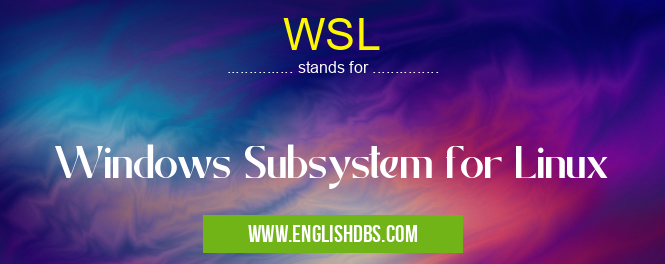What does WSL mean in UNCLASSIFIED
WSL (Windows Subsystem for Linux) is a compatibility layer for running Linux binary executables (in ELF format) natively on Windows 10 and Windows 11 operating systems. It's a Windows 10 feature that allows users to run a GNU/Linux environment directly on their Windows system without the need for a virtual machine or dual-booting.

WSL meaning in Unclassified in Miscellaneous
WSL mostly used in an acronym Unclassified in Category Miscellaneous that means Windows Subsystem for Linux
Shorthand: WSL,
Full Form: Windows Subsystem for Linux
For more information of "Windows Subsystem for Linux", see the section below.
Key Features of WSL
- Native Linux Environment: WSL provides a native Linux environment within Windows, allowing users to run Linux commands, tools, and applications seamlessly.
- No Virtualization Overhead: Unlike virtual machines, WSL doesn't require virtualization, reducing resource overhead and improving performance.
- File System Integration: WSL seamlessly integrates with the Windows file system, allowing users to access and modify files from both Linux and Windows environments.
- Interoperability with Windows Applications: WSL can interact with Windows applications, enabling users to launch Linux programs from Windows and share data between the two systems.
- Distributions: WSL supports various Linux distributions, including Ubuntu, Debian, Fedora, and Kali Linux, allowing users to choose their preferred operating system.
Benefits of Using WSL
- Develop and Test Cross-Platform Applications: WSL provides a convenient platform for developing and testing applications that need to run on both Windows and Linux systems.
- Enhanced Productivity: By eliminating the need to switch between operating systems, WSL improves productivity for developers who work with both Windows and Linux tools.
- Simplified DevOps: WSL simplifies DevOps workflows by allowing developers to use familiar Linux tools and scripts within the Windows environment.
- Access to Linux-Exclusive Software: WSL enables users to access and use Linux-exclusive software and tools without leaving the Windows ecosystem.
Essential Questions and Answers on Windows Subsystem for Linux in "MISCELLANEOUS»UNFILED"
What is Windows Subsystem for Linux (WSL)?
WSL is a Windows feature that allows users to run a Linux distribution directly on their Windows 10 or 11 machine. It provides a Linux-compatible environment that can run Linux binaries, tools, and applications without the need for a separate virtual machine or dual-boot setup.
What are the benefits of using WSL?
WSL offers several advantages, including:
- Enhanced developer experience: Developers can use familiar Linux tools and workflows within their Windows environment, simplifying software development and cross-platform compatibility.
- Improved performance: WSL leverages Windows' hardware virtualization capabilities, providing near-native performance for Linux applications.
- Simplified management: WSL can be easily installed and managed through the Microsoft Store, allowing users to switch between Windows and Linux environments seamlessly.
What Linux distributions can I run with WSL?
WSL supports various Linux distributions, including:
- Ubuntu
- Debian
- Fedora
- CentOS
- Kali Linux
- openSUSE
- Alpine Linux Users can download and install these distributions directly from the Microsoft Store.
How do I install WSL?
To install WSL, follow these steps:
- Enable the Windows Subsystem for Linux feature: Go to Control Panel > Programs > Turn Windows Features On or Off and check the box for "Windows Subsystem for Linux."
- Download and install a Linux distribution from the Microsoft Store.
- Launch the Linux distribution and create a user account. Your Linux environment will be ready to use.
Can I use WSL with Windows 7 or 8?
No, WSL is only available for Windows 10 and 11.
Are there any limitations to WSL?
While WSL provides a robust Linux experience, it has some limitations, including:
- Hardware support: WSL does not have direct access to all of the hardware on your Windows machine, including specialized peripherals like graphics cards.
- File system integration: WSL uses a separate file system from Windows, which can limit file sharing between the two environments.
- Network compatibility: WSL may experience network connectivity issues with certain applications or services that rely on Windows-specific networking protocols.
Final Words: WSL is a powerful tool that enhances the Windows experience for developers and users who require a Linux environment. It offers a seamless integration of Linux and Windows, providing the benefits of both operating systems without the complexities of virtualization. With its ease of use, performance, and versatility, WSL continues to be a valuable asset in the modern computing landscape.
WSL also stands for: |
|
| All stands for WSL |
